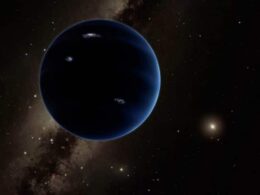
The cloud of cosmic rubble is linked to the Taurid meteor shower, whose particles were shed by a comet called 2P/Encke which orbits the Sun once every 3.3 years.
Calculations by a team at the Western University, Canada, show that the heart of the Taurid swarm (TS) will pass less than 30 million km from Earth in June, its closest approach since 1975. Its fragments are known as NEOs (Near Earth Objects) because they come close to our own orbit around the Sun.
It raises the possibility that some meteoroids from the swarm could enter our atmosphere, producing brilliant fireballs as they vaporise. But a larger meteor could make a catastrophic impact or explosion – called an airburst – if it hit an inhabited area.
According to the university’s press release, some extraterrestrial experts have likened the meteor swarm to the Loch Ness Monster and Bigfoot. But it says the Canadian team believe it may indeed pose an existential risk for Earth and its inhabitants.
In 1908, a powerful airburst occurred over a remote, forested part of Siberia called Tunguska, flattening trees for thousands of square kilometres around. The scientists say it has been suggested that it was caused by an outlying fragment from the Taurid meteor swarm.
Thankfully, Tunguska was uninhabited, but an indication of the potential for disaster came in February, 2013, when a previously unknown small asteroid exploded over the city of Chelyabinsk, Russia. The blast produced a shockwave that shattered windows and destroyed buildings, injuring around a thousand people, mainly due to glass cuts.
Canadian scientists David Clark, Paul Wiegert and Peter Brown say the Taurid swarm will come close enough to be visible with the world’s largest telescopes and are calling on major observatories to study it during July and August as it crosses the southern sky to see how dense it really is.
The university’s Western Meteor Physics Group plan to observe it for themselves in August with the Canada-France-Hawaii Telescope on Hawaii.
Some astronomers believe that Comet Encke, and its meteors, are themselves remnants of a monster comet, around 100 km wide, which disintegrated in the inner solar system 10-20 thousand years ago. This “giant comet hypothesis” was proposed by British astronomers Victor Clube and Bill Napier in 1984.
A daytime meteor shower, known as the beta Taurids, has already been shown to produce increased fireball activity when the swarm comes closest to Earth. The streams of debris are also responsible for a prolonged nighttime meteor shower through October and November which is notable for its bright fireballs.
In the science paper, The 2019 Taurid resonant swarm: prospects for ground detection of small NEOs, to be published in the Monthly Notices of the Royal Astronomical Society, the authors conclude: “The June-August 2019 encounter . . . provides a unique opportunity to identify additional NEOs of the swarm, helping to either substantiate or refute the giant comet hypothesis of Clube & Napier . . . Dedicated surveys will at the very least be able to place limits on the NEO density near the swarm centre.”


